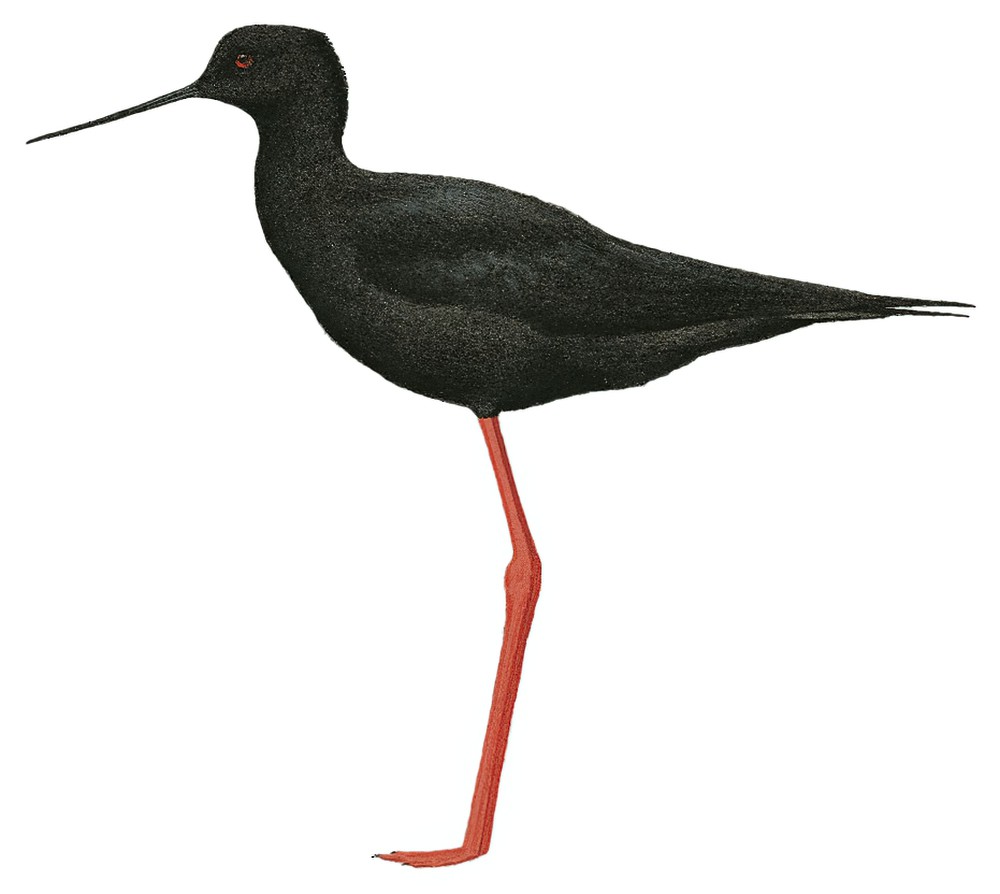Black Stilt / Himantopus novaezelandiae

Black Stilt
SCI Name:
Protonym: Himantopus novae-zelandiae BirdsAustr. pt4 pl.34
Taxonomy: Charadriiformes / Recurvirostridae / Himantopus
Taxonomy Code: blasti1
Type Locality: Port Nicholson, North Island, New Zealand.
Author: Gould
Publish Year: 1841
IUCN Status: Critically Endangered
DEFINITIONS
HIMANTOPUS
(Recurvirostridae; Ϯ Black-winged Stilt H. himantopus) L. himantopus, himantopodis wading bird now generally identified with the Black-winged Stilt < Gr. ἱμαντοπους himantopous, ἱμαντοποδος himantopodos wading bird, spindle-shanks < ἱμας himas, ἱμαντος himantos strap, thong; πους pous, ποδος podos foot; "Himantopus. Genus 67. ... Genus Himantopi. Le genre de l'Echasse. (1). ... (1) Echasse, nom que j'ai donné aux espèces de ce genre à cause de la longueur de leurs jambes. **1. L'ECHASSE. ... HIMANTOPUS." (Brisson 1760): based on "Himantopus" of ancient and later authors, and Charadrius Himantopus Linnaeus, 1758; "Himantopus Brisson, Orn., 1760, 1, p. 46; 5, p. 33. Type, by tautonymy, Himantopus Brisson = Charadrius himantopus Linné." (Peters, 1934, II, p. 289). The various allopatric subspecies of the Black-winged Stilt are each often treated as distinct and separate species (i.e. himantopus, leucocephalus, knudseni, mexicanus and melanurus).
Var. Himatopus.
Synon. Calobatus, Himantellus, Hypsibates, Macrotarsus.
himantopus
• Gr. ἱμαντοπους himantopous, ἱμαντοποδος himantopodos wading bird, spindle-shanks < ἱμας himas, ἱμαντος himantos strap, thong; πους pous, ποδος podos foot; "TRINGA HIMANTOPUS, Nobis. Bill much longer than the head, sub-arched; legs very long, toes semipalmated ... This new species, which I shot from a flock at Long Branch, New-Jersey, in the middle of July, is very remarkable for its anomalous characters. It connects still more closely than the other Tringa with subarched bills, the two genera Numenius and Tringa, since to other common traits, it unites the semipalmated toes; indeed, instead of placing it at the head of Tringa, we should place it at the last of Numenius, was it not for its long, slender, and delicate legs and toes." (Bonaparte 1826) (Calidris).
• L. himantopus, himantopodis wading bird now generally identified with the Black-winged Stilt < Gr. ἱμαντοπους himantopous, ἱμαντοποδος himantopodos wading bird, spindle-shanks < ἱμας himas, ἱμαντος himantos strap, thong; πους pous, ποδος podos foot; “The Legs and Thighs are of a wonderful length, very small and weak ... so that well and of right may it be called Himantopus, or Loripes, its Legs being soft and flexible like a thong or string” (Ray 1678); “The old name of himantopus is taken from Pliny: and, by an aukward metaphor, implies that the legs are as slender and pliant as if cut out of a thong of leather” (White 1789); "79. CHARADRIUS. ... Himantopus. 10. C. supra niger, subtus albus, rostro nigro capite longiore, pedibus rubris longissimis. Charadrius autumnalis. Hasselq. iter. 253. n. 29. Himantopus. Sibb. scot. . . t. 11. 13. Raj. av. 106. Aldr. orn. l. 20. c. 30. Gesn. av. Habitat in Europa australiore." (Linnaeus 1758) (Himantopus).
novaezealandiae / novaezeelandiae / novaezelandiae
L. novus new; Mod. L. Zeelandia Zeeland, Netherlands; i.e. New Zealand (also New Zeeland or New Zeland, which received its name from the explorer Abel Tasman who explored the west coast in 1642, naming it Nova Zeelanda after his Dutch home).
● ex “Pacific Parrakeet” of Latham 1781 (Cyanoramphus).
● Erroneous TL New Zealand (= probably Brazil) (syn. Megascops watsonii).
● Erroneous TL. New Zealand (= Falkland Islands) (syn. Phalcoboenus australis).
UPPERCASE: current genus
Uppercase first letter: generic synonym
● and ● See: generic homonyms
lowercase: species and subspecies
●: early names, variants, mispellings
‡: extinct
†: type species
Gr.: ancient Greek
L.: Latin
<: derived from
syn: synonym of
/: separates historical and modern geographic names
ex: based on
TL: type locality
OD: original diagnosis (genus) or original description (species)












